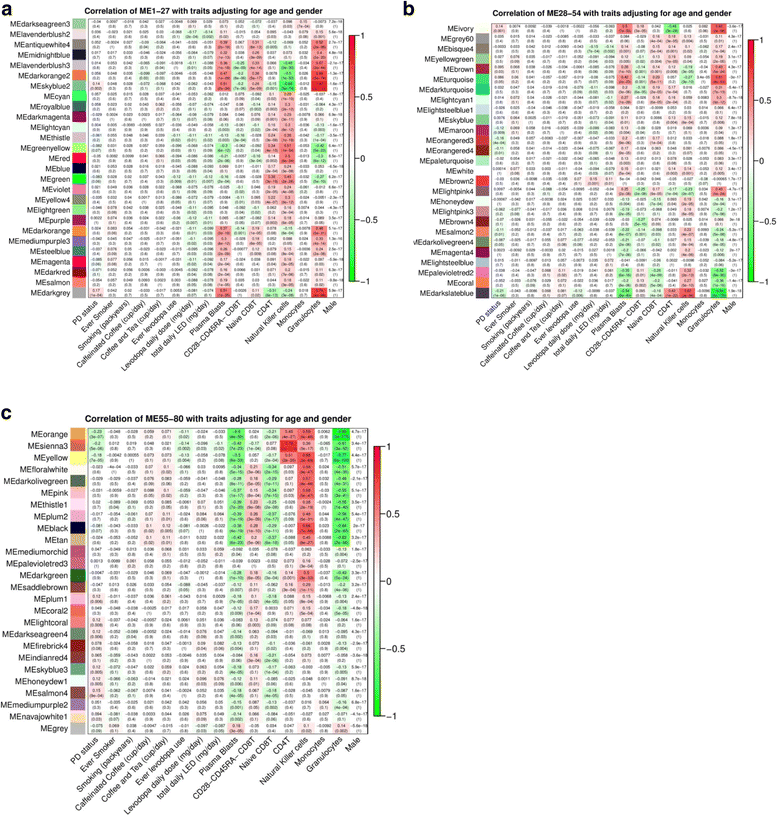Parkinson's disease is associated with DNA methylation levels in human blood and saliva
- PMID: 28851441
- PMCID: PMC5576382
- DOI: 10.1186/s13073-017-0466-5
Parkinson's disease is associated with DNA methylation levels in human blood and saliva
Abstract
Background: Several articles suggest that DNA methylation levels in blood relate to Parkinson's disease (PD) but there is a need for a large-scale study that involves suitable population based controls. The purposes of the study were: (1) to study whether PD status is associated with DNA methylation levels in blood/saliva; (2) to study whether observed associations relate to blood cell types; and (3) to characterize genome-wide significant markers ("CpGs") and clusters of CpGs (co-methylation modules) in terms of biological pathways.
Methods: In a population-based case control study of PD, we studied blood samples from 335 PD cases and 237 controls and saliva samples from another 128 cases and 131 controls. DNA methylation data were generated from over 486,000 CpGs using the Illumina Infinium array. We identified modules of CpGs (clusters) using weighted correlation network analysis (WGCNA).
Results: Our cross-sectional analysis of blood identified 82 genome-wide significant CpGs (including cg02489202 in LARS2 p = 8.3 × 10-11 and cg04772575 in ABCB9 p = 4.3 × 10-10). Three out of six PD related co-methylation modules in blood were significantly enriched with immune system related genes. Our analysis of saliva identified five significant CpGs. PD-related CpGs are located near genes that relate to mitochondrial function, neuronal projection, cytoskeleton organization, systemic immune response, and iron handling.
Conclusions: This study demonstrates that: (1) PD status has a profound association with DNA methylation levels in blood and saliva; and (2) the most significant PD-related changes reflect changes in blood cell composition. Overall, this study highlights the role of the immune system in PD etiology but future research will need to address the causal structure of these relationships.
Keywords: Bioinformatics; Blood cell counts; Cytoskeleton; DNA methylation; Epigenomics; Immune system; Mitochondrial dysfunction; Parkinson’s disease; Saliva; WGCNA.
Conflict of interest statement
Ethics approval and consent to participate
The study was approved by the UCLA Institutional Review Board (IRB# 11-001530) and informed consent was obtained from all individuals. Our research conformed to the Declaration of Helsinki.
Consent for publication
Not applicable, since this manuscript does not contain any individual person’s data in any form, e.g. individual details, images, or videos.
Competing interests
The authors declare that they have no competing interests.
Publisher’s Note
Springer Nature remains neutral with regard to jurisdictional claims in published maps and institutional affiliations.
Figures



Similar articles
-
Epigenome-wide DNA methylation analysis in siblings and monozygotic twins discordant for sporadic Parkinson's disease revealed different epigenetic patterns in peripheral blood mononuclear cells.Neurogenetics. 2017 Jan;18(1):7-22. doi: 10.1007/s10048-016-0497-x. Epub 2016 Oct 6. Neurogenetics. 2017. PMID: 27709425
-
Longitudinal Epigenome-Wide Methylation Study of Cognitive Decline and Motor Progression in Parkinson's Disease.J Parkinsons Dis. 2019;9(2):389-400. doi: 10.3233/JPD-181549. J Parkinsons Dis. 2019. PMID: 30958317 Free PMC article.
-
Organophosphate pesticide exposure and differential genome-wide DNA methylation.Sci Total Environ. 2018 Dec 15;645:1135-1143. doi: 10.1016/j.scitotenv.2018.07.143. Epub 2018 Jul 21. Sci Total Environ. 2018. PMID: 30248838 Free PMC article.
-
Emerging Role of Environmental Epitranscriptomics and RNA Modifications in Parkinson's Disease.J Parkinsons Dis. 2024;14(4):643-656. doi: 10.3233/JPD-230457. J Parkinsons Dis. 2024. PMID: 38578904 Free PMC article. Review.
-
Epigenetic Biomarkers for Parkinson's Disease: From Diagnostics to Therapeutics.J Parkinsons Dis. 2017;7(1):1-12. doi: 10.3233/JPD-160914. J Parkinsons Dis. 2017. PMID: 27792016 Free PMC article. Review.
Cited by
-
DNA Methylation Signature of Aging: Potential Impact on the Pathogenesis of Parkinson's Disease.J Parkinsons Dis. 2023;13(2):145-164. doi: 10.3233/JPD-223517. J Parkinsons Dis. 2023. PMID: 36710687 Free PMC article. Review.
-
DNA Methylation: A Promising Approach in Management of Alzheimer's Disease and Other Neurodegenerative Disorders.Biology (Basel). 2022 Jan 7;11(1):90. doi: 10.3390/biology11010090. Biology (Basel). 2022. PMID: 35053088 Free PMC article. Review.
-
Integrative analysis identifies DNMTs against immune-infiltrating neutrophils and dendritic cells in colorectal cancer.Epigenetics. 2019 Apr;14(4):392-404. doi: 10.1080/15592294.2019.1588684. Epub 2019 Mar 16. Epigenetics. 2019. PMID: 30880552 Free PMC article.
-
Stochastic Epigenetic Mutations Influence Parkinson's Disease Risk, Progression, and Mortality.J Parkinsons Dis. 2022;12(2):545-556. doi: 10.3233/JPD-212834. J Parkinsons Dis. 2022. PMID: 34842194 Free PMC article.
-
Genome-wide DNA methylation patterns associated with sleep and mental health in children: a population-based study.J Child Psychol Psychiatry. 2020 Oct;61(10):1061-1069. doi: 10.1111/jcpp.13252. Epub 2020 May 3. J Child Psychol Psychiatry. 2020. PMID: 32361995 Free PMC article.
References
Publication types
MeSH terms
Grants and funding
LinkOut - more resources
Full Text Sources
Other Literature Sources
Medical
Molecular Biology Databases

